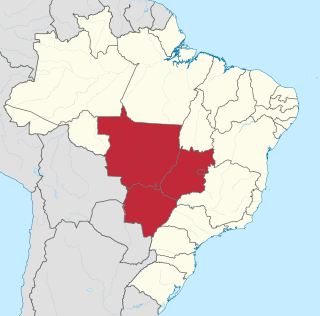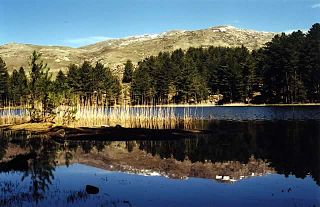
Mato Grosso is one of the states of Brazil, the third largest by area, located in the Central-West region. The state has 1.66% of the Brazilian population and is responsible for 1.9% of the Brazilian GDP.

Mato Grosso do Sul is one of the Midwestern states of Brazil. Neighboring Brazilian states are Mato Grosso, Goiás, Minas Gerais, São Paulo and Paraná. It also borders the countries of Paraguay, to the southwest, and Bolivia, to the west. The economy of the state is largely based on agriculture and cattle-raising. Crossed in the south by the Tropic of Capricorn, Mato Grosso do Sul generally has a warm, sometimes hot, and humid climate, and is crossed by numerous tributaries of the Paraná River. The state has 1,3% of the Brazilian population and is responsible for 1,5% of the Brazilian GDP.

The Central-West or Center-West Region of Brazil is composed of the states of Goiás, Mato Grosso and Mato Grosso do Sul; along with Distrito Federal, where Brazil's national capital, Brasília, is situated. This Region is right in the heart of Brazil, representing 18.86% of the national territory.

The Roman scudo was the currency of the Papal States until 1866. It was subdivided into 100 baiocchi, each of 5 quattrini. Other denominations included the grosso of 5 baiocchi, the carlino of 7½ baiocchi, the giulio and paoli both of 10 baiocchi, the testone of 30 baiocchi and the doppia of 3 scudi.

Aragarças is a municipality in southwest Goiás state, Brazil.

Fabio Grosso is an Italian former professional footballer and current manager of Frosinone Calcio.

Montes Claros de Goiás is a municipality in western Goiás state, Brazil
Ouvrage Monte Grosso is a work of the Maginot Line's Alpine extension, the Alpine Line, also known as the Little Maginot Line. The ouvrage consists of one entry block, four artillery blocks and two observation blocks facing Italy. It was the largest ouvrage in the Alps It is part of the fortifications surrounding Sospel, which protect the approaches to Nice from the north.

Zilia is a commune in the Haute-Corse department of France on the island of Corsica.

Monte Beigua is a mountain in the Ligurian Apennines in Liguria, northern Italy, between the two communes of Varazze and Sassello.

Serra Monte Cristo is a Brazilian mountain range located within the state of Mato Grosso. The state's highest point is located there, measuring 1,118 meters.

Nova Monte Verde is a municipality in the state of Mato Grosso in the Central-West Region of Brazil.
The Monte Grosso oil field is an oil field located in the region of the Southern Apennines. It was discovered in 2006 and developed by Mediterranean Oil & Gas. It will begin production in 2011 and will produce oil. The total proven reserves of the Monte Grosso oil field are around 100 million barrels (17.7×106tonnes), and production is centered on 15,000 barrels per day (2,400 m3/d).

Raoni Metuktire, also known as Chief Raoni or Ropni, is an Indigenous Brazilian leader and environmentalist. He is a chief of the Kayapo people, a Brazilian Indigenous group from the plain lands of the Mato Grosso and Pará in Brazil, south of the Amazon River and along Xingu River and its tributaries. He is internationally famous as a living symbol of the fight for the preservation of the Amazon rainforest and indigenous culture.
Montegrosso or Monte Grosso may refer to:

Monte San Parteo is a mountain peak located in Monticello, Haute-Corse, Corsica. Situated between the valley of the River Melaja Tartagine and the valley of Fiume di Regino, the mountain rises to 1,680 metres (5,510 ft). It is part of the Monte Cinto massif.
The Path of Saint-Charles is an historical, artistic and devotional route which follows the travels of saint Charles Borromeo from Arona, his native town, and Viverone, where the path joins the Via Francigena.

The Monte Cinto massif is one of the main massifs in the island of Corsica, France, taking its name from the highest mountain in Corsica, Monte Cinto. It is the northernmost and highest of the four massifs that form the spine of the island. The massif is mostly in the Haute-Corse department, but the southwest of the massif is in the Corse-du-Sud department.

The Guagno is a river in the north of the department of Corse-du-Sud, Corsica, France. It is a tributary of the river Liamone.

















